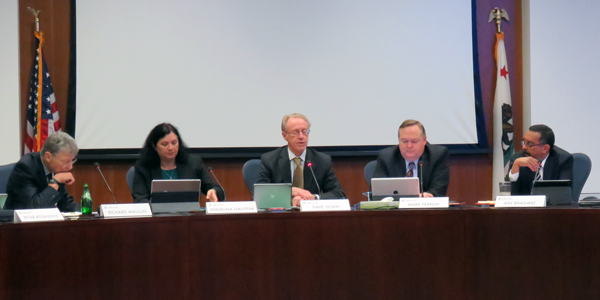By Jason Fordney
CAISO’s Board of Governors on Wednesday approved new provisions to account for errors in load forecasts by allowing grid operators to manually update the forecasts to deal with changing conditions on the grid.
At its May 16 meeting in Folsom, Calif., the board also heard from CEO Steve Berberich about the tight supply conditions the ISO foresees this summer, as well as what he called “a very serious issue” regarding inverters that caused an 860-MW loss of solar resources on April 20.
The board approved the new “imbalance conformance” rules that allow the ISO to account for errors in renewable energy forecasts or instances when generators deviate from their dispatch orders. The Energy Imbalance Market Governing Body approved the rules last month. (See EIM Body Approves Imbalance Conformance Rules.)
The board also approved alterations to the Imbalance Conformance Limiter, an ISO software tool designed to prevent price spikes caused by imbalance conformance adjustments. The limiter keeps the market from trying to dispatch more supply than is available in a particular dispatch interval to account for imprecision in the adjustments.
CAISO Department of Market Monitoring Director Eric Hildebrandt told the board that while the department supports the changes, the magnitude of load adjustments has increased dramatically, doubling between 2016 and 2017. The adjustments should be more random in nature and not used as systematically as they have been, he said.
In his presentation, Hildebrandt said “the ISO appears to use load conformance as means to procure additional imports in the hour-ahead process to ensure more ramping capacity is available in the 15-minute and five-minute markets.”
The Monitor recommends the ISO focus on how it can reduce the need for operators to make manual adjustments in real time.
Southern California Edison opposed the changes, saying that the new limiter enhancements should be implemented in addition to the old limiter logic in order to maintain price stability. Powerex also opposed the measures, saying they might suppress scarcity pricing in some situations, according to a presentation from CAISO Vice President of Market Infrastructure Keith Casey. FERC must approve the changes before they take effect.
Warnings of Tight Supply, Inverter Issues
Berberich explained to the board that on April 20, the Mira-Loma-Vincent 500-kV line in the SCE service territory relayed, causing 860 MW of solar to trip off because of voltage fluctuations.
“It’s a really exciting event down in the control room when we lose 860 MW,” Berberich said during his CEO report.
CAISO has been trying to reprogram inverter settings so they can ride through the relays and is working with NERC to create an appropriate industry-wide standard to address the problem. While the ISO has been able to reprogram some inverters, others cannot be reprogrammed, leading it to rely other resources at certain times.
“We are going to keep a close eye on this issue,” Berberich said, adding that the ISO views the new NERC standard as an important goal. He said public calls for demand reductions will be key in managing grid conditions this summer.
“We expect to have very tight conditions this summer,” Berberich said, adding that the gas system is operating at a “bare minimum.”
An ISO presentation showed that after modeling 2,000 scenarios, it was found there is a 50% probability of a Stage 2 emergency for at least one hour this summer. CAISO declares a Stage 2 emergency when it becomes clear that operating reserves will be less than 5% after dispatching all resources, including demand response. The ISO did not include in its modeling the gas supply limitations from restricted use of Aliso Canyon, which it said could represent further reliability risk. (See CPUC OKs Temporary Increase in Aliso Canyon Injections.)
FERC said last week it will closely monitor grid conditions in Southern California this summer as the region faces the likelihood of above-normal temperatures. (See FERC Keeps an Eye on ERCOT, CAISO as Hot Summer Approaches.)





